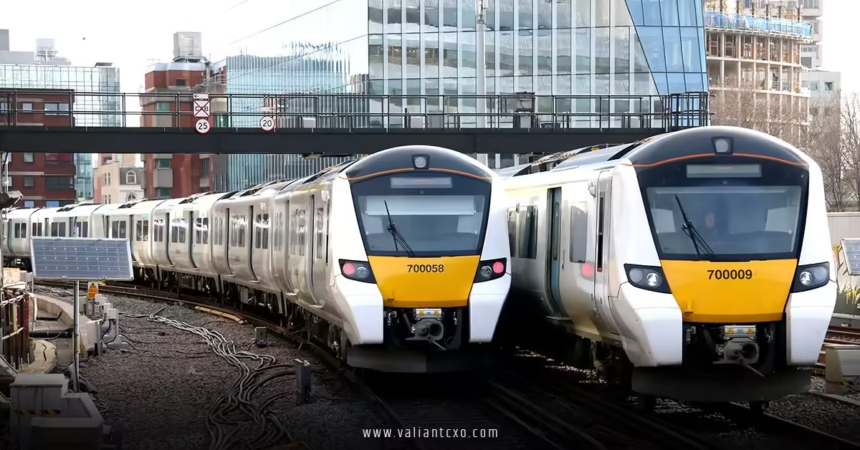Thameslink isn’t just a train service—it’s the lifeblood of London’s commuter culture, weaving together the city’s sprawling suburbs with its vibrant core. Picture a thread stitching a colorful tapestry, connecting people, places, and opportunities. That’s what Thameslink does for millions of passengers daily. Whether you’re a daily commuter, a curious tourist, or just passing through, understanding Thameslink can transform your travel experience in London and beyond. In this article, we’ll dive into what makes Thameslink special, from its history to its modern operations, and why it’s a lifeline for so many. Ready to hop aboard? Let’s explore.
What Is Thameslink? A Quick Overview
So, what exactly is Thameslink? At its heart, Thameslink is a railway network stretching across London, linking Bedford in the north to Brighton in the south, with plenty of stops in between. It’s not just another train line—it’s a cross-London marvel that cuts through the capital, offering a seamless way to travel from one side to the other without changing trains. Think of it like a subway system, but with the charm of overground views and longer routes reaching deep into southeast England.
Thameslink operates as part of the UK’s National Rail system, managed by Govia Thameslink Railway. It’s known for high-frequency services, modern trains, and key stations like St Pancras International, London Bridge, and Gatwick Airport. Whether you’re heading to work, catching a flight, or exploring historic towns, Thameslink gets you there with ease.
Why Thameslink Stands Out
Unlike other rail services, Thameslink is unique because it doesn’t skirt around London—it dives right through it. Trains pass through iconic central stations like Blackfriars and Farringdon, offering direct access to the city’s heart. Plus, it connects major hubs like King’s Cross and London Bridge, making it a favorite for locals and visitors alike. Ever wondered how to zip from Gatwick to central London without multiple transfers? Thameslink is your answer.
The Scale of Thameslink’s Network
Thameslink’s reach is impressive, covering over 225 miles and serving 68 stations. It’s like a giant web, with threads extending to Bedford, Luton, Brighton, and even Rainham in Kent. With up to 24 trains per hour during peak times, Thameslink keeps London moving like a well-oiled machine.
The History of Thameslink: A Journey Through Time
Let’s take a trip back in time. The story of Thameslink begins in the 1980s, though its roots trace to earlier rail lines. The name “Thameslink” was coined in 1987 when British Rail rebranded a route crossing the River Thames, linking north and south London. It was a bold move—imagine building a bridge to connect two distant shores, only with trains instead of bricks.
From Humble Beginnings to Modern Marvel
Originally, Thameslink was a modest service, but it grew rapidly thanks to infrastructure investments. The Thameslink Programme, a massive upgrade launched in the 2000s, transformed it into today’s powerhouse. New tracks, modern trains, and revamped stations like Blackfriars made Thameslink faster and more reliable. It’s like giving a classic car a turbo-charged engine—suddenly, it’s ready to race.
Key Milestones in Thameslink’s Evolution
- 1988: Thameslink officially launches, connecting Bedford to Brighton.
- 2009: The Thameslink Programme begins, expanding capacity and upgrading stations.
- 2018: New Class 700 trains are introduced, offering more space and comfort.
- 2020: Thameslink goes fully digital with in-cab signaling, boosting efficiency.
These milestones show how Thameslink has adapted to meet the needs of a growing city, much like a river carving a new path through the landscape.
How Thameslink Works: Routes and Destinations
Wondering where Thameslink can take you? The network spans a vast area, with its main line running from Bedford to Brighton and branches reaching places like Luton, St Albans, and Sevenoaks. Whether you’re planning a seaside getaway or a business meeting, Thameslink has a route for you.
Major Routes of Thameslink
- Bedford to Brighton: The flagship route, passing through central London and Gatwick Airport.
- Luton to Rainham: Serving southeast London and Kent.
- St Albans to Sutton: Perfect for suburban commuters in Hertfordshire and south London.
Each route is designed to maximize convenience, like a well-planned road trip with all the best stops.
Key Stations to Know
Some Thameslink stations are more than just stops—they’re gateways. Here are a few standouts:
- St Pancras International: A grand Victorian station connecting to Eurostar for international travel.
- London Bridge: A bustling hub for south London commuters.
- Gatwick Airport: Your direct link to stress-free airport travel.
These stations are like the jewels in Thameslink’s crown, each offering unique connections and experiences.
Why Choose Thameslink? Benefits for Commuters and Travelers
Why hop on a Thameslink train instead of the Tube or a bus? For starters, it’s fast, frequent, and far-reaching. Thameslink trains run every few minutes during peak hours, and their cross-London routes save you the hassle of multiple transfers. It’s like having a personal chauffeur who knows all the shortcuts.
Seamless Airport Connections
Heading to Gatwick or Luton Airport? Thameslink is a game-changer. With direct trains to both airports, you can skip expensive taxis or crowded coaches. A trip from central London to Gatwick takes just 30 minutes—faster than you can say “boarding pass.”
Comfort and Modern Amenities
Thameslink’s Class 700 trains are a breath of fresh air. Spacious carriages, free Wi-Fi, and air-conditioning make your journey comfortable. Ever tried working on a train with spotty internet? With Thameslink, that’s a thing of the past. The trains are designed with passengers in mind, like a cozy café on wheels.
Affordable Fares
Compared to other rail services, Thameslink offers competitive prices. You can save even more with railcards or off-peak tickets. It’s like finding a great deal on your favorite coffee shop’s latte—small savings add up over time.
Thameslink and the Environment: A Greener Way to Travel
In a world where sustainability matters, Thameslink shines. Trains are one of the greenest ways to travel, producing far less carbon than cars or planes. Thameslink’s modern fleet is energy-efficient, and digital signaling reduces delays, keeping emissions low. Choosing Thameslink is like planting a tree with every trip—you’re helping the planet while getting where you need to go.
Sustainability Initiatives
- Electric Trains: Thameslink’s entire fleet runs on electricity, cutting fossil fuel use.
- Regenerative Braking: Trains recycle energy during braking, boosting efficiency.
- Paperless Tickets: Mobile tickets and contactless payments reduce waste.
These efforts make Thameslink a leader in eco-friendly travel, like a green superhero in the world of transportation.
Challenges and Criticisms of Thameslink
Let’s be real—no service is perfect. Thameslink has its share of challenges. Delays, especially during peak hours, can frustrate commuters. Overcrowding is another issue, particularly on busy routes. When you’re squished into a packed carriage, it’s hard to appreciate the free Wi-Fi. But Thameslink is working on solutions, with ongoing upgrades to increase capacity and reliability.
Common Complaints and Solutions
- Delays: Thameslink is investing in better signaling to minimize disruptions.
- Crowding: More frequent trains and longer carriages are being rolled out.
- Ticket Prices: Flexible fare options are being introduced to ease the burden.
It’s a work in progress, like renovating a house while still living in it, but Thameslink is committed to improving.
Tips for Getting the Most Out of Thameslink
Want to make your Thameslink journey as smooth as possible? Here are some insider tips:
- Travel Off-Peak: Avoid rush hours (7-9 AM and 5-7 PM) for a quieter ride.
- Use Contactless: Tap in and out with your card or phone for hassle-free ticketing.
- Check Live Updates: The Thameslink website and app provide real-time service info.
- Book Early for Airport Trips: Secure cheaper fares by planning ahead.
These tips are like a cheat code for stress-free travel, helping you navigate Thameslink like a pro.
Thameslink for Tourists: Exploring London and Beyond
If you’re visiting London, Thameslink is your ticket to adventure. From St Pancras, you can connect to Eurostar for Paris or Brussels. Heading to Brighton for a beach day? Thameslink gets you there in about an hour. It’s like a magic carpet whisking you from city to coast.
Must-Visit Destinations on Thameslink
- Brighton: A vibrant seaside town with a famous pier and quirky shops.
- St Albans: A historic city with Roman ruins and a stunning cathedral.
- Cambridge: A short connection from Thameslink’s King’s Cross for academic charm.
These destinations make Thameslink a tourist’s best friend, offering easy access to England’s treasures.
The Future of Thameslink: What’s Next?
What’s on the horizon for Thameslink? The network is always evolving, with plans for more trains, faster services, and better accessibility. Imagine a future where Thameslink trains are even more eco-friendly, with solar-powered stations or AI-driven schedules to eliminate delays. The possibilities are endless, and Thameslink is poised to keep leading the way.
Upcoming Improvements
- More Trains: Plans to increase frequency on popular routes.
- Accessibility Upgrades: Better facilities for disabled passengers.
- Digital Enhancements: Smarter apps for ticketing and journey planning.
Thameslink’s future is as bright as a sunny day at Brighton beach, with innovation driving it forward.
Conclusion: Why Thameslink Matters
Thameslink is more than a railway—it’s a lifeline connecting people to jobs, adventures, and each other. From its rich history to its modern upgrades, Thameslink embodies progress while keeping London moving. Whether you’re a daily commuter or a first-time visitor, Thameslink offers a reliable, affordable, and green way to travel. So next time you’re planning a trip across London or beyond, hop on a Thameslink train and experience the journey for yourself. Where will Thameslink take you today?
FAQs About Thameslin
What Is the Main Purpose of Thameslink?
Thameslink connects north and south London, linking suburbs to the city center and serving key destinations like Gatwick Airport and Brighton. It’s designed for commuters, tourists, and anyone needing efficient cross-London travel.
How Can I Save Money on Thameslink Tickets?
To save on Thameslink fares, travel off-peak, use a railcard, or book in advance for airport routes. Contactless payments also simplify ticketing and often offer the best rates.
Does Thameslink Offer Wi-Fi on Trains?
Yes, Thameslink provides free Wi-Fi on its Class 700 trains, making it easy to stay connected during your journey.
How Does Thameslink Support Sustainable Travel?
Thameslink uses electric trains, regenerative braking, and paperless tickets to reduce its environmental impact, making it a greener choice compared to cars or planes.
Can I Use Thameslink to Get to Gatwick Airport?
Absolutely! Thameslink offers direct trains to Gatwick Airport from central London, taking about 30 minutes—perfect for stress-free airport travel.
Read More:valiantcxo.com


